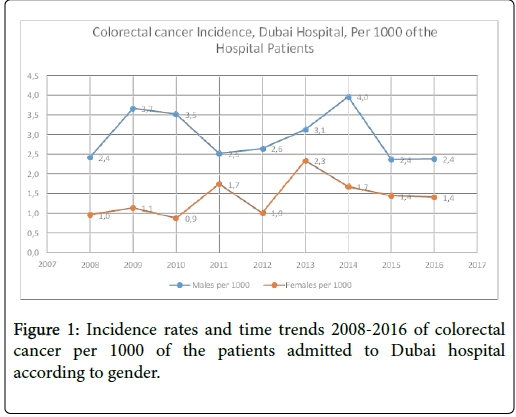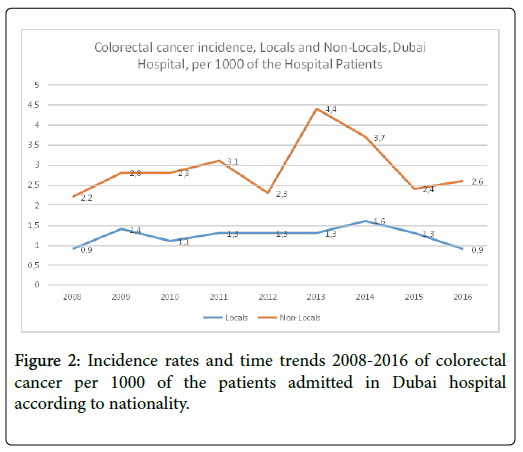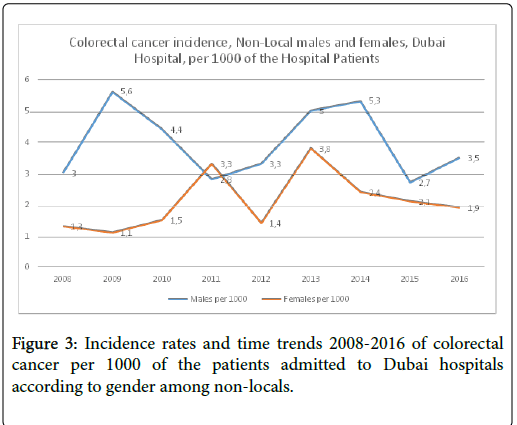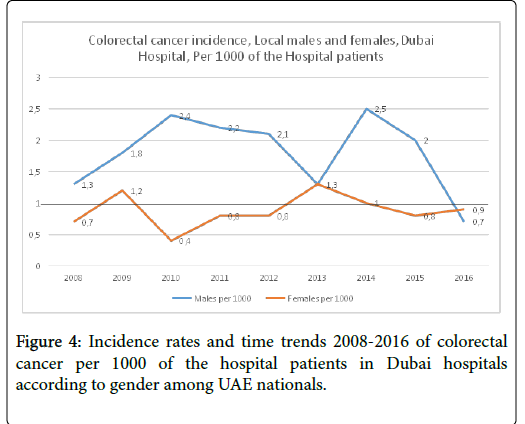Colorectal Cancer Epidemiology and Trends from 2008 to 2016 of the Cases Registered in Government Hospital, United Arab Emirates
Received: 12-Apr-2019 / Accepted Date: 06-Aug-2019 / Published Date: 13-Aug-2019 DOI: 10.4172/2165-7386.1000360
Abstract
To aim of the research is to study the incidence rates, time trends and socio-demographic associated factors of colorectal cancer among patients registered in Dubai hospital for the period 2008-2016, to study some. There was about 1.4 million new cases around the world of colorectal cancer (CRC) and almost 700 000 deaths in 2012. The distribution of CRC burden varies, with more than two- thirds of all cases and about 60% of all deaths occurring in countries with a high or very high human development index (HDI). CRC is considered one of the clearest markers of the cancer transition, replacing infection-related cancers.
Keywords: Epidemiology; Trend; Colorectal cancer; Government hospital; Dubai
Introduction
International medical literature shows that about 1.4 million new cases of colorectal cancer (CRC) are reported with around 700,000 deaths worldwide in 2012. Colorectal cancer distribution and burdens showed a wide variety, almost two-thirds of all cases or even as well as 60% of all deaths are taking place in high or very high human development index countries (HDI) [1]. Colorectal cancer is recognized as clearest markers of the cancer transition, and replacing infection-related cancers in countries went through rapid societal and economic changes. Along with other cancers predominantly linked to western lifestyles [2-4].
Recent observation shows declining trends in incidence in highincome countries. Trends appear as partially reflect, increased early detection and prevention through polypectomy (at least in the SA). In addition to all factors that have brought about declines in incidence, improvements in perioperative care, as well as chemotherapy and radiotherapy, may cause uniformly decreasing trends in CRC mortality in many high- income settings [5,6].
With the temporal profiles and demographic projections in mind, the studies revealed that the global burden of CRC is anticipated to increase by 60% counting for 2.2 million new cases and 1.1 million cancer deaths by 2030. Identifying the present profile of CRC is well understood to be the major reason behind morbidity and increasing mortality rate worldwide. The western world lifestyle like Australia, New Zealand, USA, Canada, and other European countries are identified to be reflecting the major portion of Colon cancer diagnosis and deaths. Yet lifestyles in other countries such as China, India, Africa and South America stayed at the lowest risks in case of colon cancer [7-10].
Colon cancer remains first in male’s gender and third in females in Saudi Arabia among all other cancers. KSA is currently recognized to be with a low incidence rate in case of Colon cancer, nonetheless, it has been shown that over the last ten years the number of Colon cancer identified and registered and the mortality rates due to CRC has been increasing significantly. Older persons aged 75 years or more are more prone to this cancer. [11-14].
Methodology
Hospital based cancer registry and records in Dubai Hospital for the period 2008-2016 has been revised. All cases were confirmed and treated in Dubai hospital. All ages, genders and nationalities were included.
Incidence varied from year to year. The incidence among males was 2.4 per 1000 in 2008, 3.5 per 1000 in 2010, and then decreased to 2.5 per 1000 in 2011. It became 4.0 per 1000 in 2014 and finally decreased to 2.4 per 1000 in 2016. On the other hand, the incidence was lower among female, which was 1.0 per 1000 in 2008, and increased to 1.7 per 1000 in 2011, 2.3 per 1000 in 2013, and decreased to 1.4 per 1000 in 2016. Among Emarati, incidence was 0.9 per 1000 in 2008. There was no increase as the incidence was also 0.9 per 1000 in 2016. Among non-Emirati, the incidence was 2.2 per 1000 in 2008, reached 4.4 per 10.000 in 2013, and dropped again to 2.6 per 1000 in 2016.
Results
Figure 1 shows the incidence rates of colorectal cancer cases registered in Dubai hospital per 1000 of the registered patients from 2008 to 2016.
Figure 2 shows incidence according to nationality. Among Emarati, incidence was 0.9 per 1000 in 2008. There was no increase as the incidence was also 0.9 per 1000 in 2016. Among non- Emirati, the incidence was 2.2 per 1000 in 2008, reached 4.4 per 10.000 in 2013, and dropped again to 2.6 per 1000 in 2016.
Figure 3 shows the incidence of colorectal cancer among non-locals. Among males, the incidence was 3.0 per 1000 in 2008, 5.6 per 1000 in 2019, 2.8 per 1000 in 2011, 5.3 per 1000 in 2014 and 3.5 per 1000 in 2016. Among females, it was 1.3 per 1000 in 2008, 3.3 per 1000 in 2011, 1.4 per 1000 in 2012, 3.8 per 1000 in 2013 and 1.9 per 1000 in 2016.
Figure 4 shows the incidence of colorectal cancer among Emirati. Among males, the incidence was 1.3 per 1000 in 2008, 2.4 per 1000 in 2010, 1.3 per 1000 in 2013, 2.5 per 1000 in 2014 and 0.7 per 1000 in 2016. Among females, it was 0.7 per 1000 in 2008, 0.4 per 1000 in 2010, 1.3 per 1000 in 2013, 1.0 per 1000 in 2014 and 0.9 per 1000 in 2016.
Discussion
Cancer contributes to the implementation of public health studies to evaluate public health risks as a tool for epidemiological surveillance, and as a decision-making aid for local and national public health authorities [15]. A current study showed that colorectal cancer among registered patients in Dubai hospital during 2014 showed high incidence. The Cancer Registry of Abu Dhabi in United Arab Emirates 2013 shows results based on percentage of all cancers. Colorectal cancer was the second most common cancer, accounting for 9% of all cancers. It is the most common cancer 14% of all cancers in males and third in females 7% of all cancers. Most (60%) of the colorectal cancer cases were men and 40% were women, 85% of cases are 40 years and above [16]. This explains that it is an important health problem especially among men.
As we noticed from the result, the colorectal cancer incidence was more among men than women. The same result was found In Saudi Arabia by counted 324 cases of CRC from 2006 to 2013 in Medina, from which 61% were male and the mean age was 57 [17]. The neighboring country, Jordan, had the highest incidence rate of CRC in the Arab Countries age- standardized rate (ASR)=25.59. According to GLOBOCAN (2012), Jordan had the second place for the incidence of CRC after Palestine. As study done by Ismail et al. in Jordan revealed that Colorectal was the most common cancer in Jordanian males from 1996 to 2009 [18]. In Saudi Arabia and Yemen, studies have reported a higher proportion of male to female in patients with CRC. In contrast result was found in Qatar and Iran which showed that risk of malignancies was more in females compared to males, and from southeast of Iran, which reported that the risk of CRC was slightly higher in females than males [19].
Recent studies showed a significant increase in the incidence of CRC in developing nations [20]. As it was found in result part, the incidence was higher in expatriate population more than the Emirati population. It seems that the ethnicity is considered as risk factors for CRC. The incidence among expatriate cases was 2.2 per 1000 of the patients which were admitted to Dubai Hospital in 2008, and reach the peak of 4.4 per 1000 in 2013 while, the incidence among the Emirati was without any peak. Among ethnic groups in Asia, the incidence of CRC is significantly higher among the Chinese [21].
Variations between registries, along with the overall pattern of increasing colorectal cancer incidence, were found in Asian the countries included in our analyses. Economic development is known to be related to changes in risk factors for colorectal cancer [22]. This corresponds to variances in colorectal cancer incidence across European countries [5]. Japanese migrants to the United States have been shown to have higher colorectal cancer incidence than people residing in Japan, suggesting that environmental exposures are a main contributor to colorectal cancer risk [23]. Colorectal cancer has shown significant international and geographical variations. Traditionally, it was known to be almost exclusive to developed and western countries. While the largest incidence of CRC was reported in Republic of Czech, Australia, New Zealand, Canada and US, the least was from Central Africa, India, and Central Asia [2].
Conclusion
The study concluded that colorectal cancer is more among males compared to females, and among expatriates compared to UAE nationals. The time trends show nearly steady state. Increase the awareness of importance of early screening and adhere to the international recommendations by regular physical activity, a variety of dietary factors, the regular use of aspirin or nonsteroidal antiinflammatory drugs (NSAIDs), and hormone replacement therapy in postmenopausal women. None of these factors is currently used to stratify CRC screening recommendations. Strengthening cancer registry system should be given a priority. Finally, preventive as well as early screening program for high risky groups are significantly recommended.
References
- Ferlay J, Ervik M, Dikshit R, Eser S, Mathers C, et al. (2013) GLOBOCAN 2012 v1.0, Cancer Incidence and Mortality Worldwide: IARC Cancer Base No. 11. Lyon, France: International Agency for Research on Cancer.
- Center MM, Jemal A, Smith RA, Ward A (2009) Worldwide variations in colorectal cancer. CA Cancer J Clin 59: 366-378.
- Bosetti C, RodrÃguez T, Chatenoud L, Bertuccio P, Levi F, et al. (2011) Trends in cancer mortality in Mexico, 1981-2007. Eur J Cancer Prev 20: 355-363.
- Bray F (2014) Transitions in human development and the global cancer burden. In: Steward BW, Wild CP, Eds. World Cancer Report 2014. Lyon: International Agency for Research on Cancer, 54-68.
- Center MM, Jemal A, Ward E (2009) International trends in colorectal cancer incidence rates. Cancer Epidemiol Biomarkers Prev 18: 1688-1694.
- Murphy CC, Harlan LC, Lund JL, Lynch CF, Geiger AM (2015) Patterns of colorectal cancer care in the United States: 1990-2010. J Natl Cancer Inst Vol: 107.
- Anele C, Adeqbola SO, Askari A, Rajendran A, Clark SK, et al. (2017) Risk of metachronous Colon cancer following colectomy in Lynch syndrome: A systematic review and meta-analysis. Colorectal Dis 19: 528-536.
- Kosumi K, Masugi Y, Yang J, Qian ZR, Kim SA, et al. (2017) Tumor SQSTM1 (p62) expression and T cells in Colorectal cancer. Oncoimmunology 6.
- Goel S, Negassa A, Khot A, Goyal D, Guo S, et al. (2017) Comparative Effectiveness Research: The Impact of Biologic Agents in Ethnic Minorities With Metastatic Colorectal Cancer. Clin Colorectal Cancer 16: 286-292.
- Alsanea N, Abduljabbar AS, Alhomoud S, Ashari L, Hibbert D, et al. (2015) Colorectal cancer in Saudi Arabia: incidence, survival, demographics and implications for national policies. Ann Saudi Med 35:196-202.
- Kingdom of Saudi Arabia Saudi Health Council Saudi Cancer Registry (2013) Cancer Incidence Report Saudi Arabia.
- Alnuwaysir M, Baral N, Alhadhari H (2016) Colon Cancer Awareness and Attitude among Adult, Al-Dammam, Saudi Arabia. Adv Cancer Prev 1: 1-4.
- Al-Sheikh YA, Shaik AP, Shaik AS (2015) Colorectal cancer: A review of the genome-wide association studies in the kingdom of Saudi Arabia. Saudi J Gastroenterol 21: 123-128.
- Joachim C, Véronique-Baudin J, Razanakaivo M, Macni J, Pomier A, et al. (2017) Trends in colorectal cancer in the Caribbean: A population-based study in Martinique, 1982-2011. Rev Epidemiol Sante Publique 65: 181-188.
- Albasri A, Yosef H, Hussainy AS, Sultan SA, Alhujaily A (2014) Histopathological features of colorectal cancer in Al-Madinah region of Saudi Arabia: 8 years’ experience. Asian Pac J Cancer Prev 15: 3133-3137.
- Ismail SI, Soubani M, Nimri JM, Al-Zeer AH (2013) Cancer incidence in Jordan from 1996 to 2009-A comprehensive study. Asian Pac J Cancer Prev 14: 3527-3534.
- Haghdoost AA, Chamani G, Zarei MR, Rad M, Heshmatpoor M, et al. (2011) Low incidence of colorectal cancer in Kerman province, Iran. Iran J Cancer Prev 4: 33-37.
- Torre LA, Bray F, Siegel RL, Ferlay J, Lortet-Tieulent J, et al. (2015) Global cancer statistics, 2012. CA Cancer J Clin. 65: 87-108.
- Lee HP, Lee J, Shanmugaratnam K (1987) Trends and ethnic variation in incidence and mortality from cancers of the colon and rectum in Singapore, 1968 to 1982. Ann Acad Med Singapore 16: 397-401.
- Drewnowski A, Popkin BM (1997) The Nutrition Transition: New Trends in the Global Diet 55: 31-43.
- Flood DM, Weiss NS, Cook LS, Emerson JC, Schwartz SM et al. (2000) Colorectal cancer incidence in Asian migrants to the United States and their descendants. Cancer Causes Control 11: 403-411.
Citation: Salim NA, Hussain H, Chehab F, Kathamuthu R, Mehairi AA, et al. (2019) Colorectal Cancer Epidemiology and Trends from 2008 to 2016 of the Cases Registered in Government Hospital, United Arab Emirates. J Palliat Care Med 9:360. DOI: 10.4172/2165-7386.1000360
Copyright: © 2019 Salim NA, et al. This is an open-access article distributed under the terms of the Creative Commons Attribution License, which permits unrestricted use, distribution, and reproduction in any medium, provided the original author and source are credited.
Share This Article
Recommended Conferences
42nd Global Conference on Nursing Care & Patient Safety
Toronto, CanadaRecommended Journals
Open Access Journals
Article Tools
Article Usage
- Total views: 3094
- [From(publication date): 0-2019 - Apr 25, 2025]
- Breakdown by view type
- HTML page views: 2313
- PDF downloads: 781




